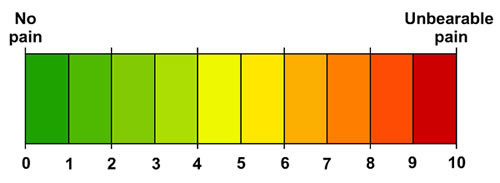Two weeks later the stroke nurse Bev visits Bob at home. His wife Jean has phoned the nurse in advance of the visit to say she is anxious about him. He appears to be in pain and has gradually become withdrawn. Jean feels his mood is low. She has also noticed he has become increasingly sensitive to touch.
Bev asked Bob to assess his pain on a scale of 1 to 10. The following are two examples of assessment scales:
An example of a Faces Pain Scale: Wong-Baker FACES Pain Rating Scale
An example of a Visual Analogue Scale:

Q. Where is the pain?
A. Down my left side, but worse in my arm and into my hand.
Q. On a scale of 1-10, how bad is the pain? 1 is mild and 10 is severe
A. In my arm it is a 10, and in the rest of my left side it is a 8.
Q. What does if feel like?
A. Intense burning like an ice burn.
Q. When do you feel the pain?
A. I always have the pain but sometimes it’s worse than others.
Q. What aggravates it?
A. Anything touching my skin is painful.
Q. What eases the pain?
A. Nothing!
Q. How does the pain interfere with your life?
A. I have problems sleeping and I have moved into the spare room.
Q. Is the pain having an effect on the way you are feeling?
A. Yes I’m tired and fed up.
Page last reviewed: 28 Apr 2020


